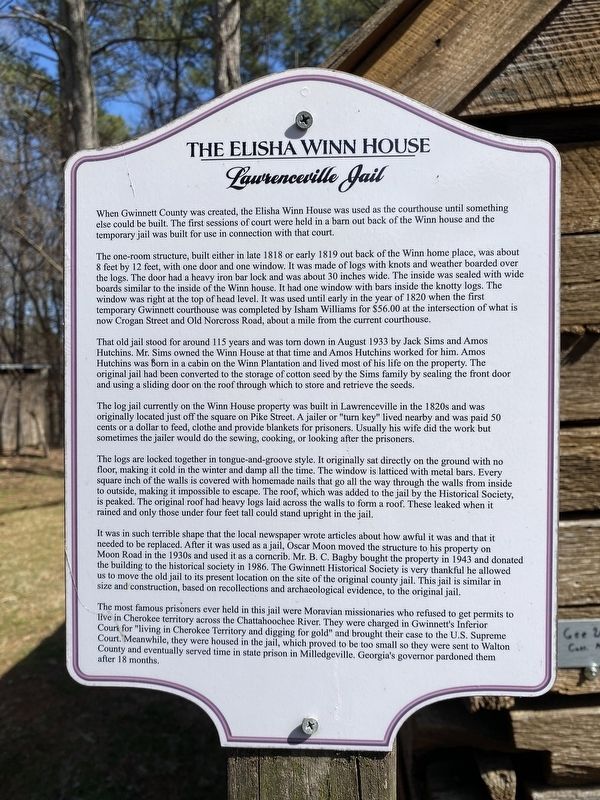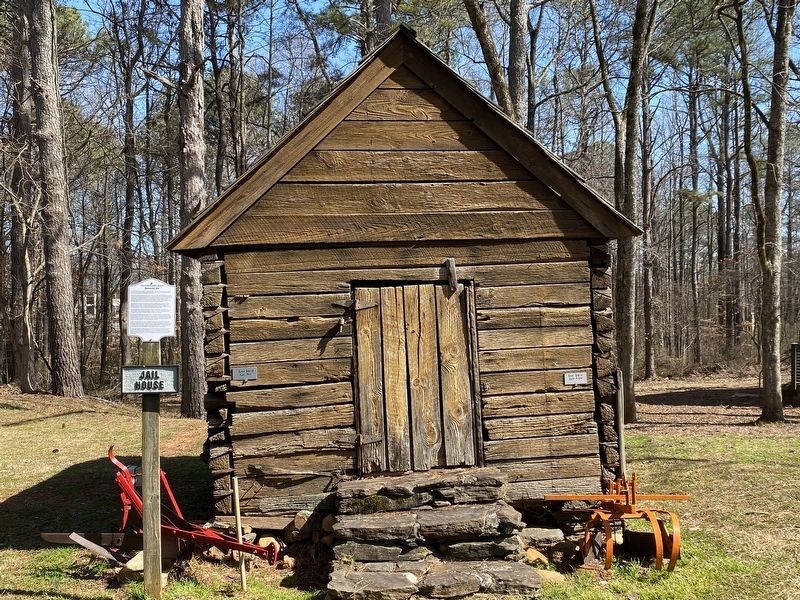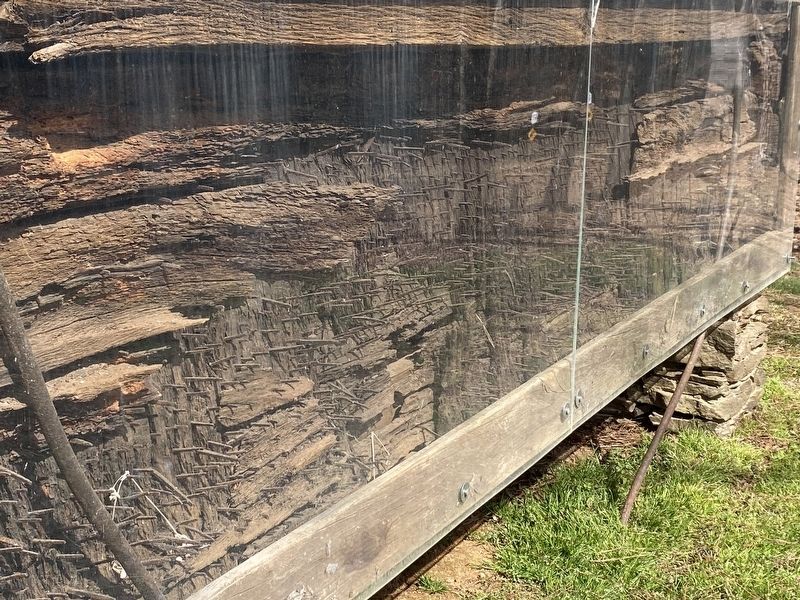Dacula in Gwinnett County, Georgia — The American South (South Atlantic)
The Elisha Winn House
Lawrenceville Jail
Inscription.
When Gwinnett County was created, the Elisha Winn House was used as the courthouse until something else could be built. The first sessions of court were held in a barn out back of the Winn house and the temporary jail was built for or in connection with that court.
The one-room structure, built either in late 1818 or early 1819 out back of the Winn home place, was about 8 feet by 12 feel, with one door and one window. It was made of logs with knots and weather boarded over the logs. The door had a heavy iron bar lock and was about 30 inches wide. The inside was sealed with wide boards similar to the inside of the Winn house. It had one window with bars inside the knotty logs. The window was right at the top of head level. It was used until early in the year of 1820 when the first temporary Gwinnett courthouse was completed by Isham Williams for $56.00 at the intersection of what is now Crogan Street and Old Norcross Road, about a mile from the current courthouse.
That old jail stood for around 115 years and was torn down in August 1933 by Jack Sims and Atmos Hutchins. Mr. Sims owned the Winn House at that time and Amos Hutchins worked for him. Amos Hutchins was born in a cabin on the Winn Plantation and lived most of his life on the property. The original jail had been converted to the storage of cotton seed by the Sims family by sealing the front door and using a sliding door on the roof through which to store and retrieve the seeds.
The log jail currently on the Winn House property was built in Lawrenceville in the 1820s and was originally located just off the square on Pike Street. A jailer or "turn key" lived nearby and was paid 50 cents or a dollar to feed, clothe and provide blankets for prisoners. Usually his wife did the work but sometimes the jailer would do the sewing, cooking, or looking after the prisoners.
The logs are locked together in tongue and groove style. It originally sat directly on the ground with no floor, making it cold in the winter and damp all the time. The window is latticed with metal bars. Every square inch of the walls is covered with homemade nails that go all the way through the walls from inside to outside, making it impossible to escape. The roof, which was added to the jail by the Historical Society, is peaked. The original roof had heavy logs laid across the walls to form a roof. These leaked when it rained and only those under four feet tall could stand upright in the jail.
It was in such terrible shape that the local newspaper wrote articles about how awful it was and that it needed to be replaced. After it was used as a jail, Oscar Moon moved the structure to his property on Moon Road in the 1930s and used it as a corncrib.
Mr. B. C. Bagby bought the property in 1943 und donated the building to the historical society in 1986. The Gwinnett Historical Society is very thankful he allowed us to move the old jail to its present location on the site of the original county jail. This jail is similar in size and construction, based on recollections and archaeological evidence, to the original jail.
The most famous prisoners ever held in this jail were Moravian missionaries who refused to get permits to live in Cherokee territory across the Chattahoochee River. They were charged in Gwinnett's Inferior Court for "living in Cherokee Territory and digging for gold" and brought their case to the U.S. Supreme Court. Meanwhile, they were housed in the jail, which proved to be too small so they were sent to Walton County and eventually served time in state prison in Milledgeville. Georgie's governor pardoned them after 18 months.
Topics. This historical marker is listed in this topic list: Notable Buildings.
Location. 34° 1.446′ N, 83° 54.496′ W. Marker is in Dacula, Georgia, in Gwinnett County. Marker can be reached from Dacula Road, 0.6 miles south of Auburn Road (Georgia Route 324), on the left when traveling south. Touch for map. Marker is at or near this postal address: 908 Dacula Rd, Dacula GA 30019, United States of America. Touch for directions.
Other nearby markers. At least 8 other markers are within 2 miles of this marker
, measured as the crow flies. A different marker also named The Elisha Winn House (here, next to this marker); a different marker also named The Elisha Winn House (a few steps from this marker); a different marker also named The Elisha Winn House (within shouting distance of this marker); a different marker also named The Elisha Winn House (about 300 feet away, measured in a direct line); a different marker also named Elisha Winn House (about 400 feet away); The Dr. William Hinton House (approx. 1.6 miles away); Stone Structures (approx. 1.6 miles away); Old Oak Tree (approx. 1.9 miles away). Touch for a list and map of all markers in Dacula.
Also see . . . Elisha Winn House. Gwinnett County Parks & Recreation (Submitted on March 6, 2024.)
Credits. This page was last revised on March 6, 2024. It was originally submitted on March 3, 2024, by Darren Jefferson Clay of Duluth, Georgia. This page has been viewed 42 times since then. Photos: 1, 2, 3. submitted on March 5, 2024, by Darren Jefferson Clay of Duluth, Georgia. • Bernard Fisher was the editor who published this page.


